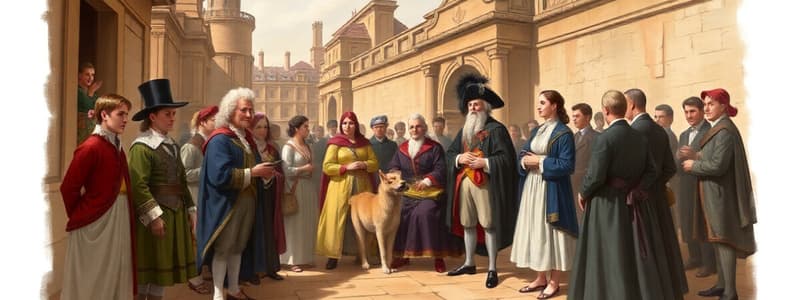Podcast
Questions and Answers
Which groups comprised the Third Estate?
Which groups comprised the Third Estate?
- Clergy
- Big businessmen, merchants, court officials, peasants, artisans, landless labourers, servants (correct)
- Educated men
- Nobility
What was the Tithe?
What was the Tithe?
A tax levied by the church, comprising one-tenth of the agricultural produce.
What is one reason for the empty treasury in France during the late 18th century?
What is one reason for the empty treasury in France during the late 18th century?
France helped the thirteen American colonies to gain their independence from Britain.
The Taille was a tax paid directly to the church.
The Taille was a tax paid directly to the church.
The subsistence crisis refers to an extreme situation where the basic means of livelihood are __________.
The subsistence crisis refers to an extreme situation where the basic means of livelihood are __________.
What did the growing middle class in the 18th century believe about societal privilege?
What did the growing middle class in the 18th century believe about societal privilege?
What characterized the population growth in France during the late 18th century?
What characterized the population growth in France during the late 18th century?
Which group bore the burden of financing activities of the state through taxes?
Which group bore the burden of financing activities of the state through taxes?
What is the tithe tax?
What is the tithe tax?
Name one form of indirect tax mentioned.
Name one form of indirect tax mentioned.
France maintained a modest court at the palace of Versailles.
France maintained a modest court at the palace of Versailles.
The extreme situation where the basic means of livelihood are endangered is known as a ______.
The extreme situation where the basic means of livelihood are endangered is known as a ______.
Which group believed that no society should have privileges by birth?
Which group believed that no society should have privileges by birth?
What consisted of the middle class in the 18th century?
What consisted of the middle class in the 18th century?
Flashcards are hidden until you start studying
Study Notes
Structure of French Society
- French society divided into three estates: Clergy, Nobility, and Third Estate (commoners).
- The Third Estate included big businessmen, merchants, court officials, peasants, artisans, landless laborers, and servants.
- Financial burdens, including taxes, fell exclusively on the Third Estate, highlighting social inequity.
Taxation System
- Tithe: Church tax of one-tenth of agricultural produce.
- Taille: Direct tax paid to the state.
- Indirect Tax: Applied to everyday consumables, such as salt and tobacco.
Economic Strain on France
- France financially supported American colonies in their war against Britain, straining the treasury.
- Lenders started demanding higher interest rates, charging up to 10% on state loans.
- The extravagant lifestyle of the royal court at Versailles contributed significantly to financial troubles.
Subsistence Crisis
- Population growth increased grain demand, exacerbating economic disparities.
- The widening gap between rich and poor led to a subsistence crisis, threatening basic livelihoods.
Rise of the Middle Class
- The 18th century saw the emergence of an educated middle class with the potential to drive societal change.
- This group opposed hereditary privilege, advocating for equality among societal groups.
- Middle class constituents included overseas traders, manufacturers, and large-scale business operators, pushing for freedom and reform against oppression.
Structure of French Society
- French society divided into three estates: Clergy, Nobility, and Third Estate (commoners).
- The Third Estate included big businessmen, merchants, court officials, peasants, artisans, landless laborers, and servants.
- Financial burdens, including taxes, fell exclusively on the Third Estate, highlighting social inequity.
Taxation System
- Tithe: Church tax of one-tenth of agricultural produce.
- Taille: Direct tax paid to the state.
- Indirect Tax: Applied to everyday consumables, such as salt and tobacco.
Economic Strain on France
- France financially supported American colonies in their war against Britain, straining the treasury.
- Lenders started demanding higher interest rates, charging up to 10% on state loans.
- The extravagant lifestyle of the royal court at Versailles contributed significantly to financial troubles.
Subsistence Crisis
- Population growth increased grain demand, exacerbating economic disparities.
- The widening gap between rich and poor led to a subsistence crisis, threatening basic livelihoods.
Rise of the Middle Class
- The 18th century saw the emergence of an educated middle class with the potential to drive societal change.
- This group opposed hereditary privilege, advocating for equality among societal groups.
- Middle class constituents included overseas traders, manufacturers, and large-scale business operators, pushing for freedom and reform against oppression.
Studying That Suits You
Use AI to generate personalized quizzes and flashcards to suit your learning preferences.




